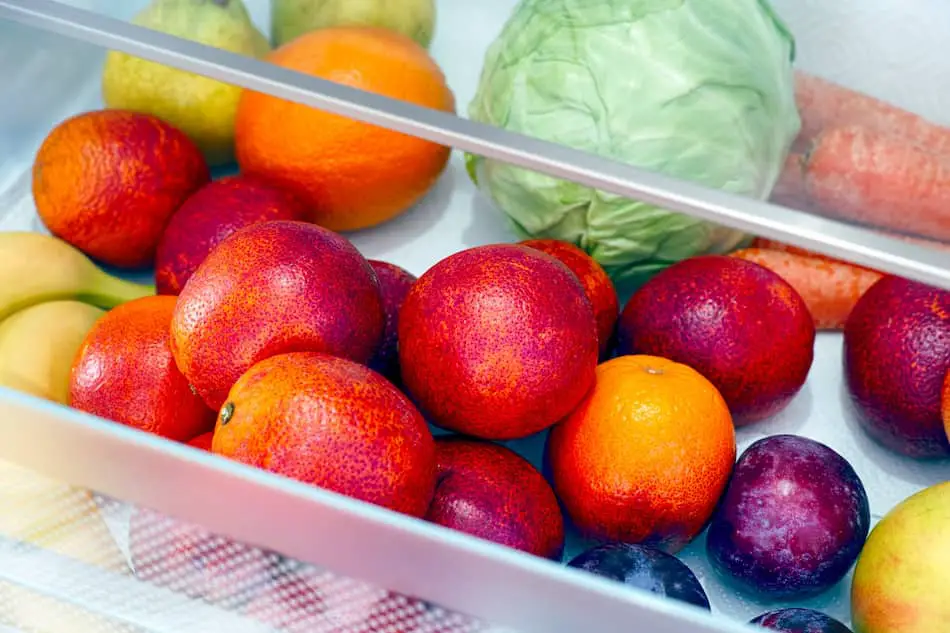
When you buy fresh produce, you want it to stay fresh as long as possible. Different fruits and vegetables should be stored in different ways, and it’s not always obvious how. Here is your complete guide, by food item, from A to Z. But first, some general tips:
Should You Wash Your Fresh Fruit and Veggies Before Putting Them Away?
Fresh produce should be stored unwashed. This is because produce tends to stay fresher longer if kept free from moisture. However, if you dry your fruit and veggies thoroughly after washing them, you can store them without causing them to spoil significantly faster. A good reason to do so is if you know you will be more likely to eat these healthy foods in the days ahead if they are already washed, trimmed, and ready to eat.
The Best Way to Wash Fresh Fruit and Vegetables
To clean your produce, the FDA recommends a simple cold water rinse. Rub produce with your fingers under cold running water for a minute or two, or until any visible soil is gone. Use a stiff brush to scrub the skins of firm produce like potatoes. More delicate produce like salad greens can be soaked—swish the leaves around in a tub of water and rinse repeatedly (make sure the tub is completely clean first).
You can wash fruit and veggies with a vinegar and water solution for more bacteria-fighting power, which might extend the shelf life of your produce. However, this isn’t necessary as a rule and will affect the flavor of the food unless rinsed very well. Store-bought produce wash isn’t necessary.
Can You Freeze Fresh Fruits and Vegetables?
Nearly all fresh fruit and vegetables can be frozen. This is a great way to ensure you always have these healthful foods on hand, and nothing goes to waste if you can’t eat fresh produce before it spoils.
Foods with a high water content like celery and oranges may have their texture ruined by freezing, but can still be used after freezing in recipes like soups or smoothies.
Most fruit and veggies will need some preparation before freezing. In general, you will need to wash, trim and blanch them to preserve their flavor and color. A great guide to blanching is here. Blanching times vary by food type and must be strictly adhered to, or the process can be counter-productive. Most produce should be cut up before freezing as well (except for berries, grapes, peas, and other small foods). Peel bananas before freezing. Thoroughly dry produce before freezing.
Which Fruits and Vegetables Should Not Be Stored Together?
Keep high-ethylene-producing foods away from other fruits and vegetables, as they will accelerate their ripening and spoiling. Some foods are particularly sensitive to ethylene production. For example, bananas are both sensitive to ethylene production and high ethylene producers, so keep them by themselves, away from all other fresh produce.
Here is a list of the high-ethylene producing fruits and vegetables, which should be stored away from other fresh fruits and vegetables 1:
- Apples
- Apricots
- Avocados
- Bananas
- Cantaloupe
- Mangos
- Peaches
- Pears
- Plums
- Potatoes
- Tomatoes
Here is a list of the fruits and vegetables most sensitive to ethylene, which means they should be stored away from the high-ethylene-producing fruits and vegetables:
- Asparagus
- Broccoli
- Brussels sprouts
- Carrots
- Cauliflower
- Cucumbers
- Eggplants
- Green beans
- Kale
- Lettuce and other salad greens
- Onions
- Parsley
- Peas
Here is a list of the fruits and vegetables that do not produce a lot of ethylene, which means they can be stored near other foods:
- Blackberries
- Blueberries
- Cherries
- Citrus (Oranges, Tangerines, Clementines, Kumquat, etc.)
- Cucumbers
- Eggplant
- Grapes
- Peppers
- Pineapples
- Raspberries
- Strawberries
- Summer squash
- Watermelon
Is it OK to Store Fruit and Veggies in Plastic?
I am not a fan of using plastic to store food. You never want to heat food in plastic, as the chemicals can transfer to your food. Even if the plastic is BPA-free, there is little proof that chemicals don’t leach onto your food. Therefore I use glass containers to store my food. A set similar to the one I use is here on amazon.
Glass containers usually have plastic lids or lid parts, but I don’t mind as long as they don’t touch the food. That’s why I’m also OK with using plastic wrap to cover bowls and dishes, as long as it doesn’t touch the food.
I also use silicone for my food storage bags rather than plastic. You can check them out here on amazon. They are sturdier than other brands. They can go in the dishwasher and freezer.
Can You Eat the Skin?
Please see my comprehensive guide to which fruit and veggies have edible skin here.
Your A to Z Guide to Storing Fresh Fruit and Vegetables
Apples
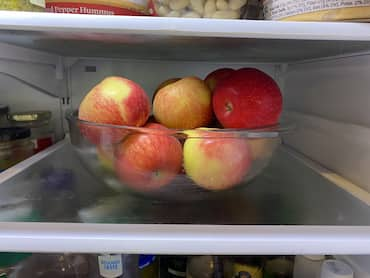
All varieties of apples should be refrigerated. If left at room temperature, they will soften much faster. In the fridge, they can last 3-4 weeks. Keep them in a bowl or loose in the crisper drawer. Sliced apples won’t last long unless you sprinkle them with lemon juice, which should help them last for a day. Or, a great tip to make a sliced apple last longer is to put the pieces back together again and hold them closed with a rubber band. Again the slices should stay fresh for at least a day.
Apricots
Store apricots at room temperature until they are ripe, and then relocate them to the refrigerator. Eat them within 1-2 days.
Artichokes
Store artichokes in a food storage bag in the crisper drawer of your refrigerator, where they will last for 1-3 days. Unlike most fresh produce, artichokes may benefit from a light sprinkling of water before storing them to keep them from drying out.
Arugula
To store arugula, wrap in paper towels, place in a food storage bag, and refrigerate. Enjoy within about 5 days.
Asparagus
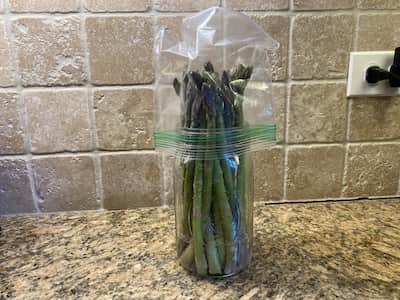
Asparagus spears are best eaten the day you buy them. If you can’t use them right away, store asparagus in the refrigerator standing up, in a glass or jar, with their stems trimmed and standing in a about an inch of water. Then cover the tops with a plastic bag. Use them within 4 days.
Avocados
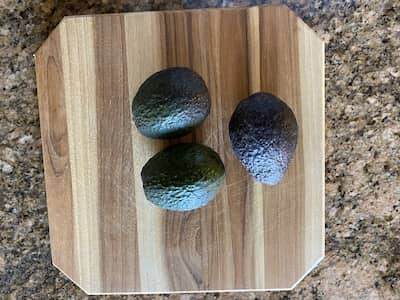
Store avocados at room temperature until they are ripe, and then relocate them to the refrigerator if you can’t use them right away. You can speed up their ripening by placing them in a closed paper bag.
Bananas
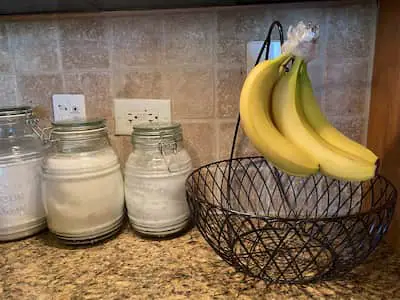
Bananas should be stored at room temperature. Wrap the stem ends in plastic to slow their ripening, as the ethylene gas, which hastens spoilage, is released from the stems. Food52 did a neat experiment showing that wrapping the stems individually in plastic wrap makes the bananas last longer than wrapping the stems as a bunch, or doing nothing. Once bananas are ripe, you can put them in the refrigerator. Their skins will turn black, but the flesh will still be edible for 5-7 days. Ideally, keep bananas away from other fruits and veggies, as the ethylene gas bananas release hastens the ripening of other foods.
Basil
To store basil and other fresh, leafy herbs, trim their stems and place them stem-side down in a glass or mason jar of water, like a bouquet of flowers. Then cover the leaf ends loosely with a plastic baggie, and place in the refrigerator. Your herbs will last 1-2 weeks this way.
Beets
To store beets, first cut off their green tops, which can speed up spoiling if left on. By the way you, you can eat beet greens—they are closely related to spinach and chard. Store beets, unwashed, in a food storage bag in the crisper drawer of your refrigerator. Beets should stay fresh this way for 2-3 weeks.
Bell Peppers (Red, Green, Yellow)
Store bell peppers of all color varieties unwashed in the refrigerator, in a food storage bag, in the crisper drawer. Eat them within 1 week.
Blackberries
Store blackberries unwashed in the refrigerator as soon as you bring them home. You can keep them in the container they came in, or transfer them to your own. The container should not be airtight, and resting them on a paper towel will help keep them stay dry and fresh.
Blueberries
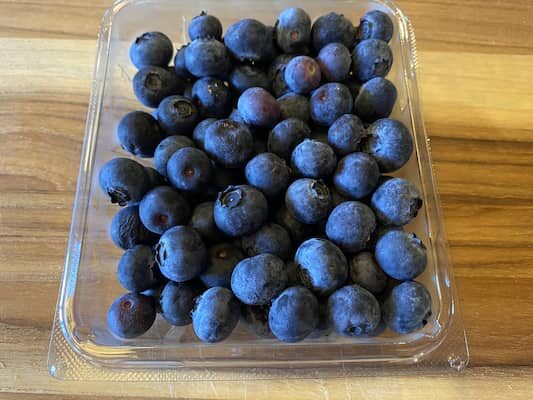
Store blueberries unwashed in the refrigerator as soon as you bring them home. You can keep them in the container they came in, or transfer them to your own. The container should not be airtight, and resting them on a paper towel will help keep them stay dry and fresh.
Bok Choy
To store bok choy, wrap it in slightly damp paper towels placed in a food storage bag, and refrigerate. Consume within 3-5 days.
Brussels Sprouts
Store Brussels Sprouts, unwashed, in a food storage bag in the crisper drawer of your refrigerator. They should last up to 5 days.
Cabbage
Store cabbage unwashed and uncut in your refrigerator. Wrap it loosely in paper towels and put it in a food storage bag. It should stay fresh for 4 weeks or longer.
Cantaloupes
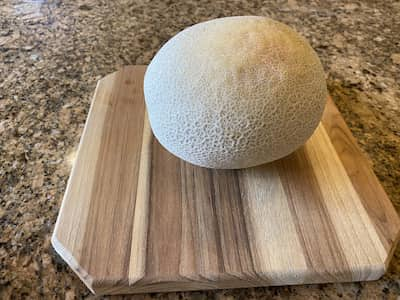
Store canteloupe at room temperature for up to about 1 week.
Carrots
To store carrots, first cut off the greens if they are still attached, as they will draw moisture away from the root, and will cause condensation in the storage container. Store carrots, unwashed, in a food storage bag in the crisper drawer of your refrigerator. Keep carrots away from ethylene gas-producing produce like apples, which will cause the carrots to spoil faster. Carrots can last as long as 3 months in the refrigerator. Some people like to store them soaking in water, but they will last longer if kept dry.
Corn
If you plan to eat corn on the cob the same day you buy it, it’s fine to keep it out at room temperature until you cook it. If you need to save it a day or two, keep it unshucked in the refrigerator, in a plastic bag. Eat corn on the cob as soon as possible, as its sugars begin converting to starch as soon as it is harvested.
Cauliflower
Store cauliflower in the refrigerator, unwashed, and wrapped in plastic, until you are ready to use it. Store it upside down to let any moisture drain away from the interior of the head.
Celery
Store celery unwashed in the crisper drawer. Some people like to store them soaking in water, but they will last longer if kept dry.
Cherries (sweet and sour)
Refrigerate sweet and sour cherries, unwashed, as soon as you bring them home. They will last up to 1 week.
Chives
Wrap chives in a damp paper towel, place them in a food storage bag, and then store them in your refrigerator crisper drawer.
Cilantro
To store cilantro and other fresh, leafy herbs, trim their stems and place them stem-side down in a glass or mason jar of water, like a bouquet of flowers. Then cover the leaf ends loosely with a plastic baggie, and place in the refrigerator. Your herbs will last 1-2 weeks this way.
Clementines (see Oranges)
Cucumbers
To store cucumbers, wrap them unwashed, individually, in a slightly damp paper towel and place them inside a food storage bin, and then place them inside the crisper drawer of your refrigerator.
Eggplants
Store eggplant, unwashed, in the refrigerator and use within a few days.
Endive
To extend freshness, store endive unwashed in a sealed food storage bag in the crisper drawer of the refrigerator, where it will keep for 4-5 days.
Figs
Store figs at room temperature for 2-3 days.
Garlic
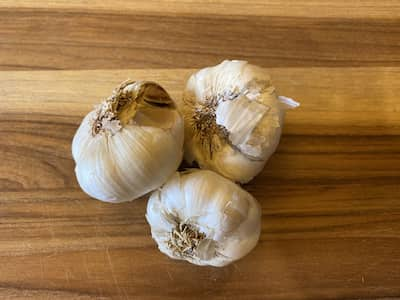
Store garlic at room temperature in a cool, dry place. Allow air circulation; do not keep it in a plastic bag. It should last 4 weeks or longer.
Ginger
Store fresh ginger in a sealed plastic bag in the refrigerator, where it can last for up to a month.
Grapefruits
Refrigerate grapefruit. When kept cool, grapefruit will stay fresh for 1-2 weeks.
Grapes (green, red or purple)
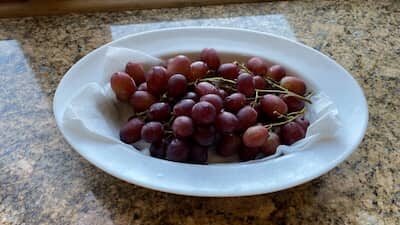
You can keep grapes of all varieties on the counter, but they will keep much longer refrigerated. Enjoy them within 1 week.
Green Beans
Store fresh green beans, unwashed, in a food storage bag kept in the refrigerator crisper drawer. Enjoy them within about a week.
Guava
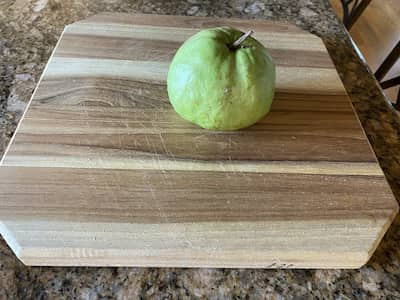
Keep guava at room temperature until it is ripe (soft to the touch). Once ripe, enjoy immediately, or store in the refrigerator crisper drawer in a food storage bag, where it will keep for 3-5 days.
Honeydew Melons
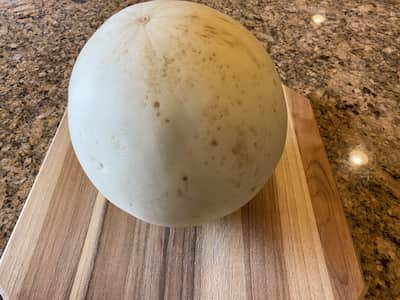
Keep honeydew melon at room temperature, and enjoy it within 2 to 3 days.
Iceberg Lettuce
Keep iceberg lettuce in the refrigerator, wrapped in a food storage bag, where it can last a couple of weeks.
Jalapeños
Place jalapeños in a paper bag and store them in the crisper drawer of your refrigerator until you’re ready to use them.
Jicama
Store jicama at room temperature in a cool, dry place.
Kale
Store kale wrapped in a paper towel and placed inside a food storage bag in your refrigerator’s crisper drawer Enjoy kale within about a week.
Kiwi Fruit
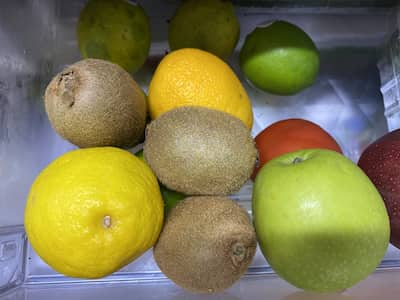
Refrigerate kiwi immediately and eat them within 1-2 weeks.
Leeks
Store leeks in the crisper drawer of the refrigerator, in a food storage bag, where they will last for up to 2 weeks.
Lemons
Although lemons look lovely on the countertop, they will last longer—1-2 weeks—if you store them in the refrigerator as soon as you bring them home.
Limes
Limes, like lemons, are beautiful in a bowl on the counter but store them in the refrigerator to keep them fresh for 1-2 weeks.
Mangos
Keep mango at room temperature, and then eat within 2 to 4 days.
Mushrooms
Mushrooms will last longer if you take them out of the container they come in. Wrap the mushrooms in paper towels placed in a paper bag, and store them in the refrigerator.
Nectarines
Keep nectarines at room temperature and eat them within a couple of days.
Onions
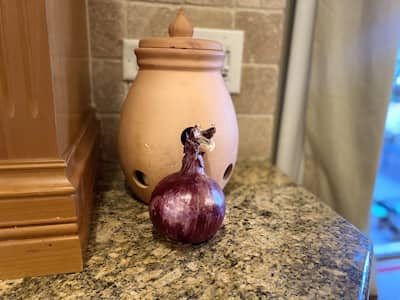
Store onions at room temperature in a cool, dry place. They don’t go in the refrigerator because the humid environment will hasten their spoilage.
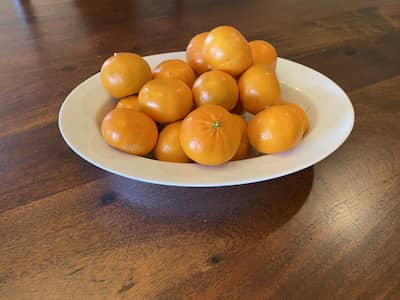
Oranges (and all citrus fruits)
Keep oranges in the refrigerator to extend their freshness. Keeping them on the counter is fine for a few days.
Parsley
To store parsley and other fresh, leafy herbs, trim their stems and place them stem-side down in a glass or mason jar of water, like a bouquet of flowers. Then cover the leaf ends loosely with a plastic baggie, and place in the refrigerator. Your herbs will last 1-2 weeks this way.
Peaches
Store peaches at room temperature and eat within a couple of days.
Pears, Anjou
Keep Anjou pears at room temperature for the best flavor. Eat them within 1-4 days.
Pears, Asian
Store Asian pears at room temperature for a week, or in the refrigerator for as long as 3 months.
Pears, Bartlett
Bartlet pears should be kept at room temperature and enjoyed within 1-4 days.
Pears, Bosc
Bosc pears should be refrigerated and enjoyed within 5-7 days.
Pears, Comice
Keep Comice pears at room temperature and eat them within 1-2 days.
Pears, Seckel
Seckel pears should be refrigerated and enjoyed within 5-7 days.
Persimmons
Keep persimmon at room temperature and then eat within 1-2 days.
Pineapples
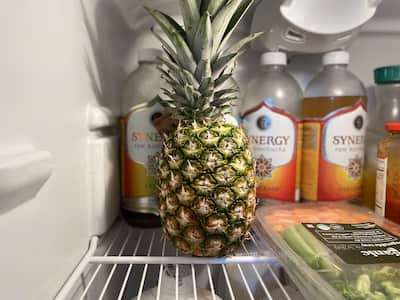
Pineapples should be refrigerated to prolong their freshness before cutting them up. Eat them in 1-2 days.
Plums
Refrigerate plums and enjoy them within 1-4 days.
Pomegranate
Pomegranates last longest in the refrigerator—from 1-4 days.
Potatoes (all varieties)
Store potatoes in a cool, dry dark place. You want to avoid exposing them to light, which can stimulate sprouting; consider throwing a towel over them. Allow air circulation; do not keep them in a plastic bag. Keep them away from onions, which release a lot of ethylene gas, and can hasten spoilage of the potatoes. Refrigerated potatoes will turn brown, soften, and increase their sugar content, changing their flavor significantly. Properly stored, potatoes can stay fresh for as long as 4 weeks.
Radishes
Wrap radishes in a damp paper towel, place them in a food storage bag and place the bag in your refrigerator’s crisper drawer. Fresh radishes may last a week or more.
Raspberries
Store raspberries unwashed in the refrigerator as soon as you bring them home. You can keep them in the container they came in, or transfer them to your own. The container should not be airtight, and resting them on a paper towel will help keep them stay dry and fresh. Enjoy them within 1-2 days.
Romaine Lettuce
Keep romaine lettuce in the refrigerator crisper drawer, wrapped in paper towels in a food storage bag, where it can last 3-5 days.
Salad Greens and Mixes, pre-washed
When buying salad greens pre-washed in plastic bins, once opened, place a paper napkin or paper towel on top of the greens to collect condensation after the lid is closed. Salad greens in plastic bags tend to spoil a bit faster because they are packed more tightly together, and are less protected from bumps and bruises. After opening bags of salad, remove as much air as possible and twist the top tightly, holding it closed with a twist-tie or rubber band. Keep bins and bags of salad refrigerated, where they will last for a couple of days.
Scallions
Wrap scallions in a slightly damp paper towel (not soaking). Then place the wrapped scallions inside a food storage bag and keep refrigerated.
Shallots
Store shallots at room temperature and allow air to circulate; do not store in a plastic bag. They should last up to 4 weeks.
Squash, Summer
Refrigerate your summer squash to keep it fresh. It should last about a week.
Squash, Winter
Keep your winter squash at room temperature in a cool, dry place. It can last up to a month.
Strawberries
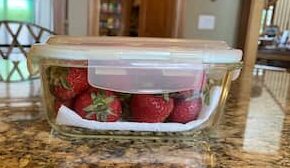
Store strawberries unwashed in the refrigerator as soon as you bring them home. You can keep them in the container they came in, or transfer them to your own. The container should not be airtight, and resting them on a paper towel will help keep them stay dry and fresh. Eat them within 1-3 days.
Sweet Potatoes
Store sweet potatoes in a cool, dry, dark place, but not in the refrigerator, which will harm the taste. They can stay good to eat for a month and beyond.
Tomatillos
Don’t remove the husks of tomatillos until you are ready to use them. Store tomatillos in their husks in a brown paper bag for 2 to 3 days in the refrigerator.
Tomatoes (all types)
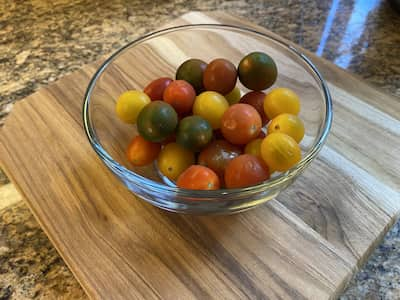
Tomatoes that are not yet ripe, or are at their peak of ripeness, should be left out at room temperature (68-72 degrees F is ideal). If you aren’t able to eat ripe tomatoes right away, then you should put them in the refrigerator. This is not common advice, but read the fantastic article at SeriousEats.com here to learn why. Just bring refrigerated tomatoes back to room temperature before eating them. Another tip—store tomatoes upside down (stem side down) for maximum juiciness. Moisture can escape through the top of the tomato, otherwise.
Watermelons
Watermelons should be refrigerated and eaten within 1 week.
Zucchini
Store zucchini, unwashed, in the refrigerator in a food storage bag kept in the crisper drawer. It should last 1-2 weeks.
Curious what vegetable is highest in fiber? Find out here.
Which is the healthiest nut of all varieties? Read about it here.
Do you use collagen? Find out about the little-known downsides here.
Resources
1 https://www.extension.iastate.edu/smallfarms/store-fresh-garden-produce-properly.
